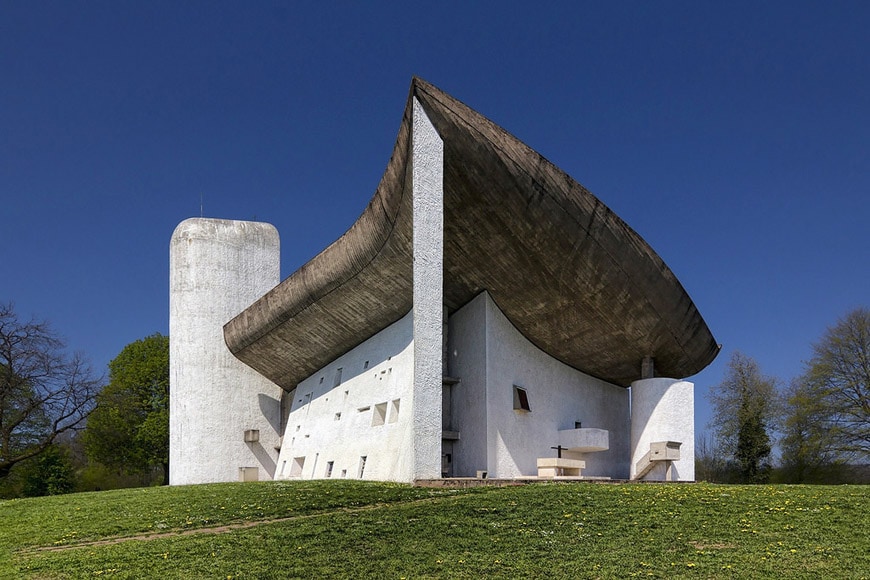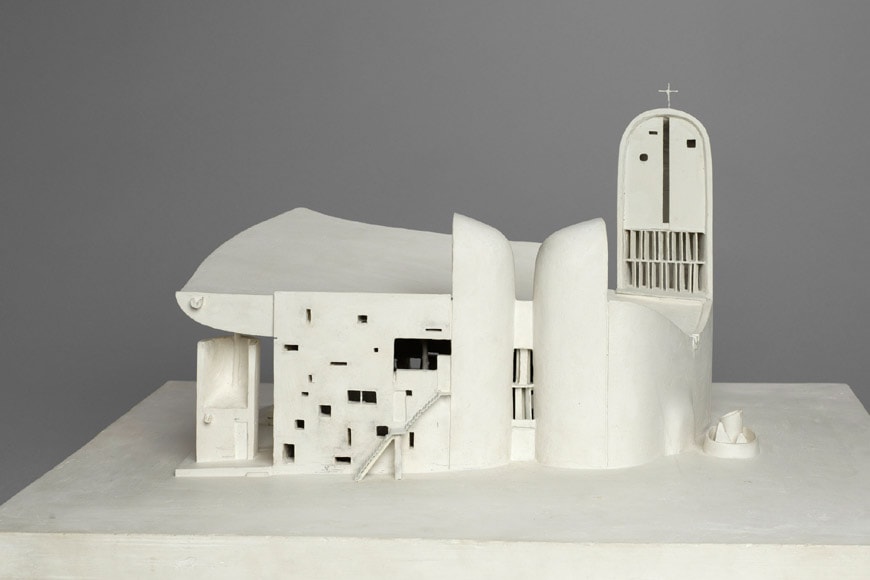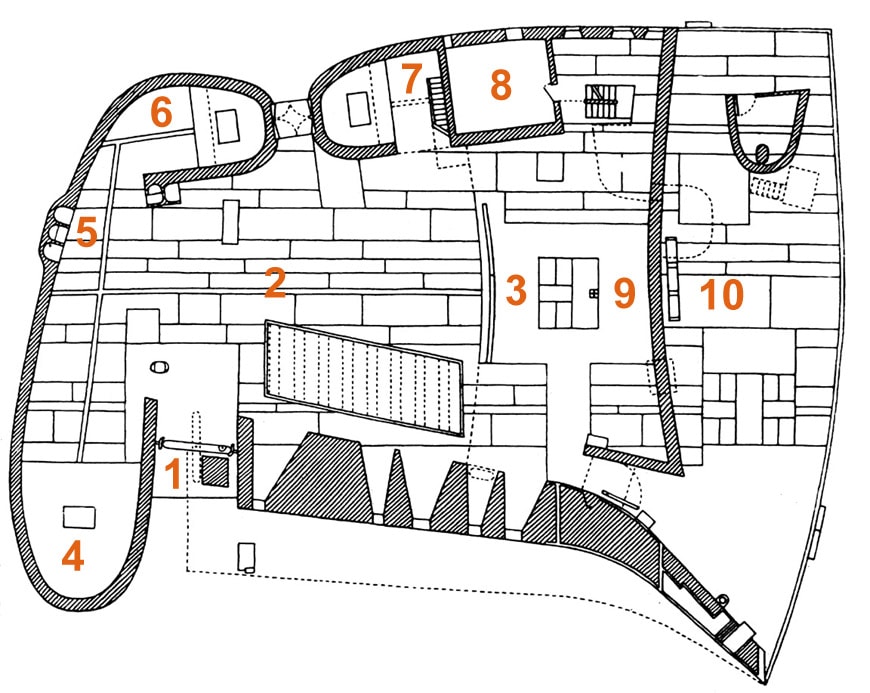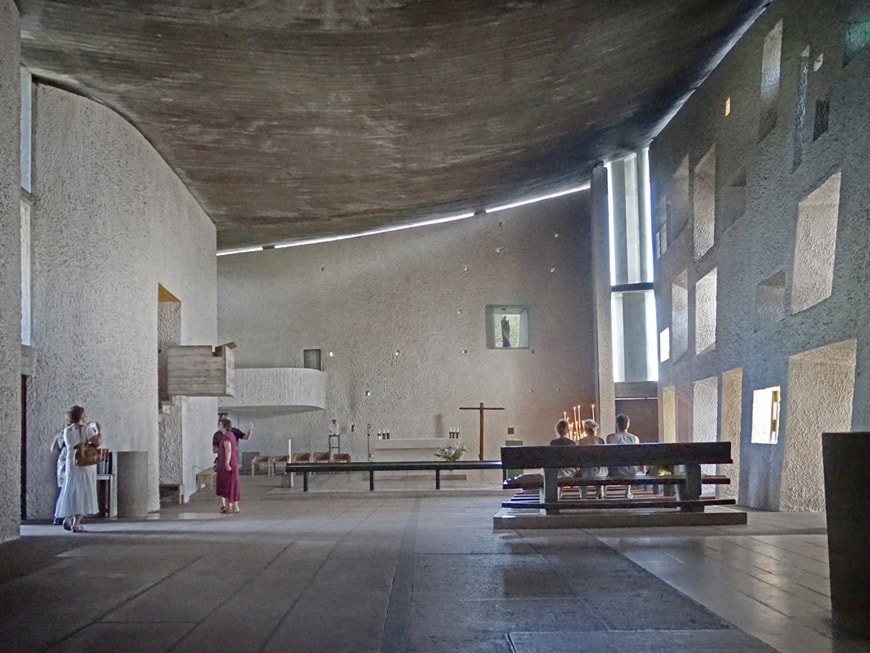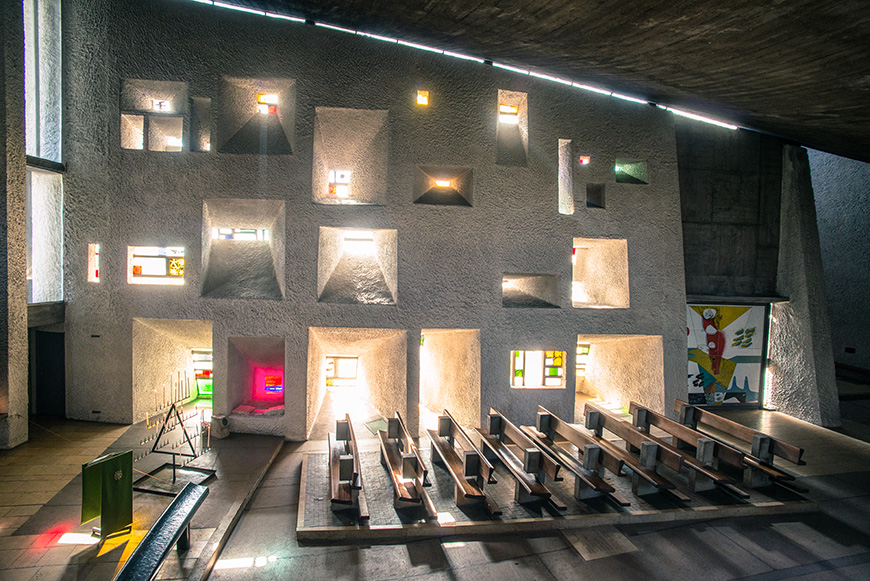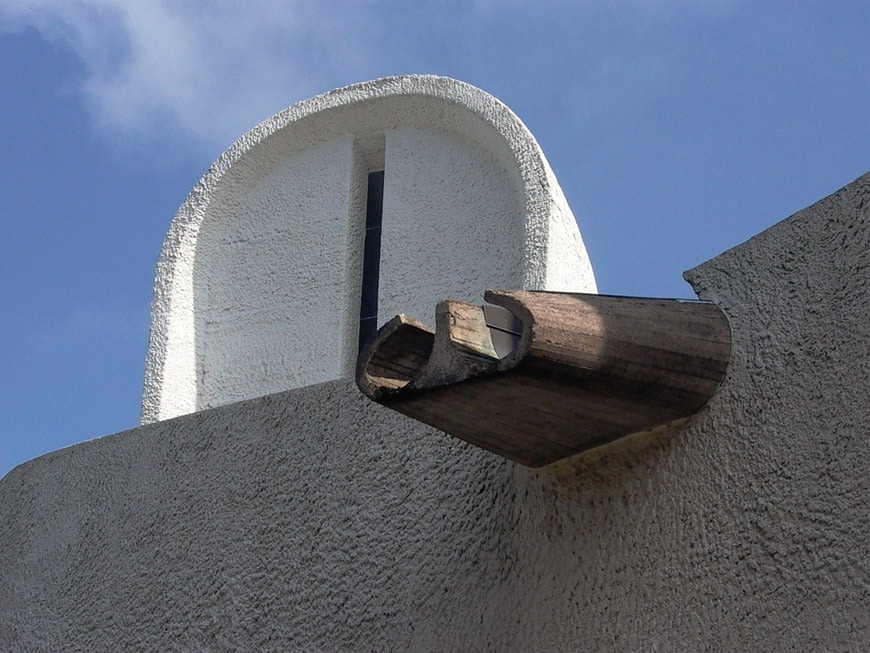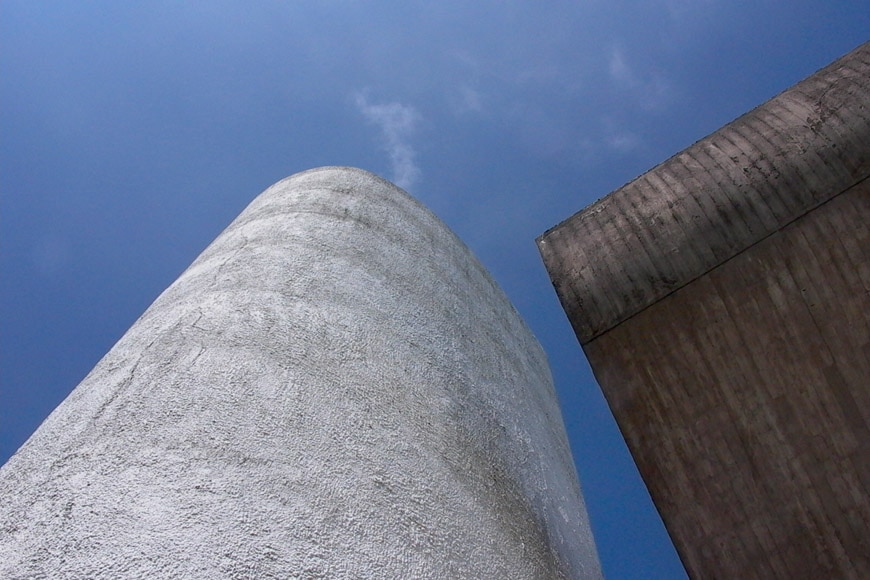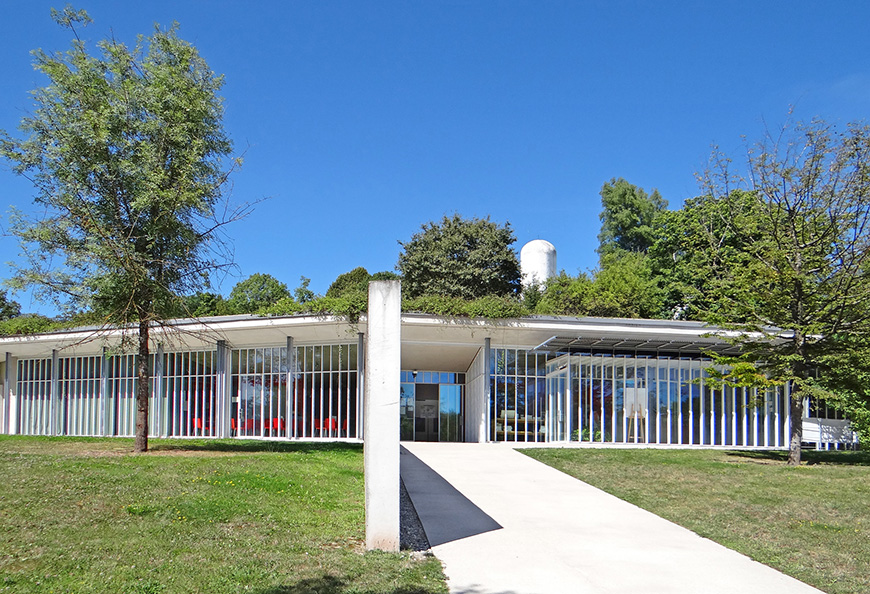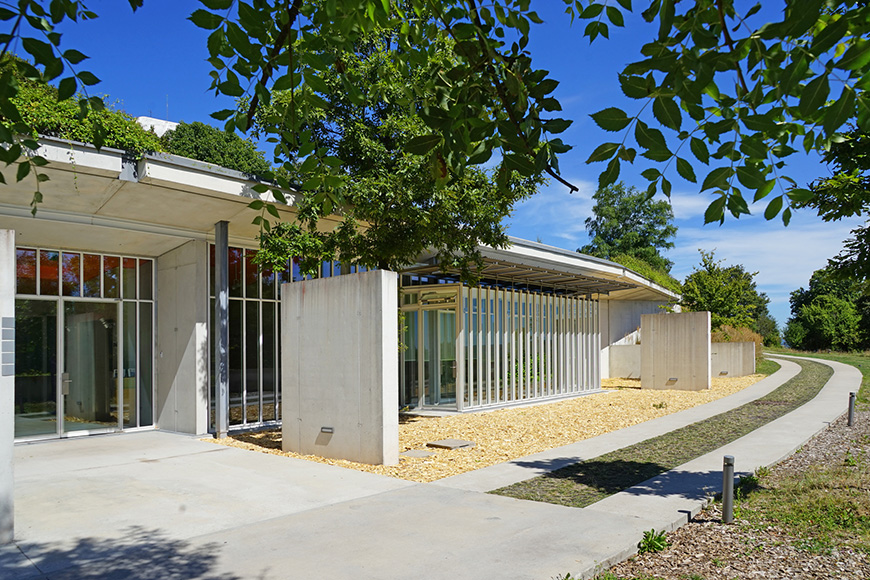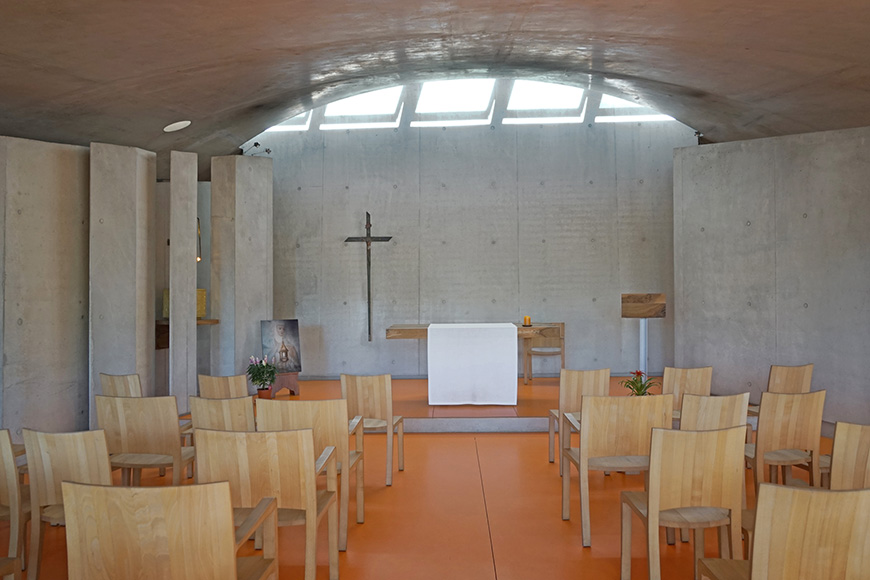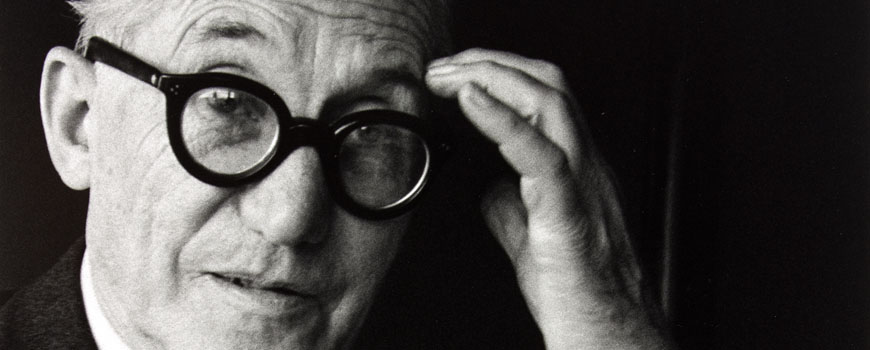The Notre Dame du Haut Chapel in Ronchamp by Le Corbusier
https://www.collinenotredameduhaut.com/en/welcome/
Notre Dame du Haut is a Catholic religious site – located near the village of Ronchamp in eastern France – world-renowned for its chapel designed by Le Corbusier in the ’50s.
Together with the main chapel, the architectural complex also comprises a monastery and a gatehouse, both designed by Renzo Piano and completed in 2011 and a nice bell tower designed by Jean Prouvé in 1975. Since 2016, the Ronchamp Chapel is a UNESCO World Heritage Site.
The village of Ronchamp with the Notre Dame du Haut site is located about 60 miles / 100 kilometers from the French-Swiss border; it’s a one-day trip from Basel, Besançon, Colmar, or Mulhouse
Cover image: the Notre Dame du Haut chapel designed by Le Corbusier, view from the south. Photo © Riccardo Bianchini/Inexhibit.
History from the 4th century to 1955
Notre Dame du Haut (meaning Our Lady of the Heights) takes its name from a sanctuary and pilgrimage chapel dedicated to the Holy Lady built in the early Middle Ages, possibly in the 4th century, on top of the hill of Bourlémont, near the village of Ronchamp, in the Bourgogne-Franche-Comté region.
Since the French Revolution, the property is privately owned by a group of about forty local families, a quite uncommon condition for a sacred Catholic site. The small medieval chapel, substantially modified over time and probably rebuilt in the 14th century, was expanded in 1859 through the addition of a Gothic revival extension.
The historic chapel, injured by a fire in 1913, was reconstructed in 1926, but then bombed and badly damaged in 1944, during World War Two.
Consequently, in 1949, the owners of the property and the Diocese of Besançon decided to completely rebuild the chapel, yet in modern forms; they, therefore, asked Le Corbusier, who was widely regarded as the most important living European architect, to design the new building.
The Swiss-French architect, who was then 63 years and hadn’t previously designed any sacred building*, was initially quite reluctant to get the task ( “I don’t want to work together with a dead institution”, he reportedly said to his potential clients) but, after visiting the place, eventually accepted the commission.
The new chapel designed by Le Corbusier was inaugurated and consecrated by the archbishop of Besançon, Marcel-Marie Dubois, on June 25, 1955.
- Le Corbusier had designed a church, the Basilica of Sainte Baume in southern France, about one year before, in 1948; yet, the project, not well accepted by the local Catholic authorities, was never built; this could also explain his reluctance to accept a new commission for a religious building
An early-20th-century French postcard depicting the Notre Dame du Haut chapel before 1913, when a fire triggered by a bolt of lightning partially destroyed it; the Gothic-revival wing on the right was completed in 1859, while the older chapel on the left dated back to the Middle Ages; source: Wikimedia Commons.
The Notre Dame du Haut chapel by Le Corbusier
The architectural concept
Between 1950 and 1953, in collaboration with architect and engineer André Maissonnier, Le Corbusier developed various drawings and scale models of the Ronchamp chapel design; yet, his architectural idea was pretty clear from the beginning.
The Swiss architect’s intention was “to create a place of silence, prayer, peace, and inner joy”. To achieve such an ambitious target he somewhat looked back at the classical and Renaissance architecture he saw between 1907 and 1911 in Italy, Greece, and Turkey during his “Grand Tour” in southern and south-eastern Europe, as well as the north-African one he saw during his 1931 travel in the Maghreb.
There is indeed more than a superficial resemblance between the white Ronchamp Chapel sitting on top of the Bourlémont Hill and the Parthenon on the Acropolis depicted in various sketches by Le Corbusier. Furthermore, the curved interior of the building was possibly inspired by those of the ancient Basilicas he visited in Rome and Istanbul.
The form of the chapel consists of a sequence of convex and concave surfaces that create the sense of being in a sort of “nest”, a space that embraces its visitors and, at the same time, seems to escape towards the sky.
That makes the building, which has a gross floor area of only 756 square meters (8,137 square feet), look much larger than it is. Le Corbusier obtained such an effect by masterfully combining gently sloped vertical walls with an imposing sail-like roof.
Furthermore, the curved shape of the building creates external areas which extend the interior of the chapel onto the surroundings. Those outdoor spaces, like that on the back of the choir, are frequently used for open-air religious events. Such a strict relationship between interior and exterior is further emphasized by the most important religious symbol in the chapel, an 18th-century revolving statue of the Holy Lady located at the back of the altar, which can be turned to aim either at the interior or at the exterior, depending on the situation.
Overall, the Ronchamp Chapel marks a discontinuity in Le Corbusier’s architectural style, which, from then on, often moved towards somewhat more organic and sinuous shapes, such as those of the Palace of Assembly in Chandigarh (1955), the Philips Pavilion (1958), and the Church of Firminy (1960).
Le Corbusier, Ronchamp Chapel, view from the east; photo: Wojtek Gurak (CC BY-NC 2.0).

Detail of the roof on the south side of the building; photo © Riccardo Bianchini/Inexhibit
Le Corbusier, Notre Dame de Ronchamp, original chalk model, 1950; the larger and the two smaller towers cover and provide daylight to the three chapels of the building; image courtesy of Centre Pompidou / Dist. RMN-GP / B. Prévost; © ADAGP, Paris 2015 (from “Le Corbusier: The Measures of Man” exhibition, 2015).
View from the east; photo John Lord (CC BY 2.0).
Interior and structure
The internal space of Notre Dame du Haut comprises a large central nave, the main chapel, two smaller side chapels (called morning chapel, and evening chapel), a sacristy, a confessional, a pulpit, and a choir opened to the outside. The building also includes a 23-meter-high (76-foot-high) tower (which contains the main chapel), and two smaller periscope-like towers designed to bring daylight into the two small chapels.
The large shell-like roof of the Ronchamp Chapel, – in designing it, Le Corbusier was reportedly inspired by an empty crab shell he found on Long Island ** – is made of two 6-centimeter-thick (2.36 inches) concrete membranes separated by a gap up to 2.26 meters (7.41 feet) wide, the upper membrane is covered with waterproofing aluminum tiles.
The membranes enclose a load-bearing structure composed of large transverse girders connected by rectangular joists, all made in reinforced concrete.
The roof is supported by two rows of concrete pillars, larger and tapered on the south side and smaller and straight on the north side, connected by concrete struts; this load-bearing structure was then “encased” on the south side of the building into thin walls made by spraying gunite (a fluid concrete which can be easily pneumatically projected onto curved surfaces) on a steel mesh, while the walls on the north, east and west sides are partially made with stones reclaimed from the old chapel’s remains.
A thin horizontal gap separates the perimeter walls from the roof, thus providing further natural lighting to the chapel’s interior.
The floor of Notre Dame du Haut, paved in stone, is gently sloped accordingly with the natural inclination of the hilltop.
Internally, the chapel contains an ensemble of decorative elements and pieces of furniture also designed by Le Corbusier, including a large revolving door decorated on both sides with enamel steel tiles, colored glass windows decorated with texts and figures, an enamel steel tabernacle, three altars in white stone, wooden benches and a cross made in collaboration with Breton cabinetmaker and sculptor Joseph Savina.
Plan of the Ronchamp Chapel: 1 – main entrance, 2 – nave, 3 – main altar, 4 – grand chapel, 5 – confessionals, 6 – evening chapel, 7 – morning chapel, 8 – sacristy, 9 – choir, 10 – the back choir external space
Interior view of the chapel toward the main altar; photo: Jean-Pierre Dalbéra (CC BY 2.0).
The south facade of the chapel is “pierced” by a series of tapered windows decorated with drawings and handwriting by Le Corbusier; photo Groucho (CC BY-NC-ND 2.0).
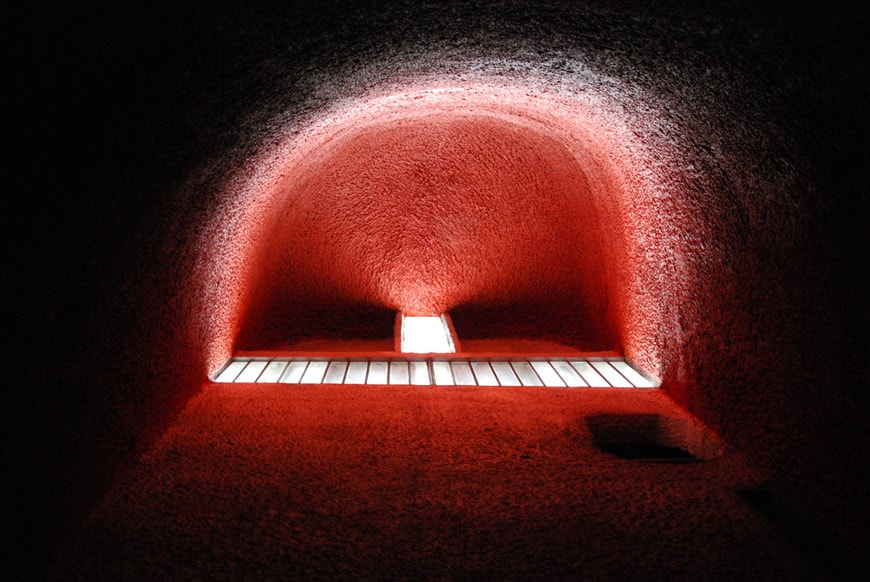
Notre Dame du Haut, the red-painted evening chapel; photo: Duncan Standridge (CC BY-NC-ND 2.0).
Together with the chapel, Le Corbusier designed other two buildings on the site, both completed in 1959: the Maison du Chapelain (Chaplain’s House) and the Abri du pèlerin (Pilgrim Shelter) – two simple single-story constructions, now covered by a green roof -, as well as a small stepped-pyramid-shaped memorial dedicated to the French soldiers who died during the liberation of France from the Nazi occupation and made, as some portions of the Chapel’s walls, with stones reclaimed from the old building’s remains.
As mentioned, the complex also includes a small portico, designed by Jean Prouvé in 1975 and made with carbon steel hollow profiles, which supports three bells, two of which were recovered from the old chapel. Le Corbusier originally envisaged adding a bell tower, physically separated from the chapel and located north of it, but died in 1965 before designing it.
Overall, Le Corbusier’s chapel, whose form and concept detach themselves from the traditional, old-fashioned models of the time, anticipates the “new sacred architecture” that the Second Vatican Council II envisaged about ten years later.
Le Corbusier, the “Pilgrim shelter” guest house, completed in 1959; photo: Wojtek Gurak (CC BY-NC 2.0).
The bell portico designed by Jean Prouvé in 1975; photo: Jean-Pierre Dalbéra
Exterior views and details of the Ronchamp Chapel; photos © Riccardo Bianchini/Inexhibit
** Le Corbusier, and Jean Petit. “Textes et dessins pour Ronchamp”. 1964. Association oeuvre N.D. de Ronchamp. p. 20
Renzo Piano’s expansion
In September 2011, a major expansion and renovation project for Notre Dame du Haut was completed after a design by Renzo Piano Building Workshop (RPBW).
The expansion comprises a new gatehouse and a new Poor Clare Sisters’ convent.
Both buildings are ingeniously carved into the hill’s slope, so as to not impede or spoil the view of Le Corbusier’s chapel.
The gatehouse (called La Porterie in French) accommodates a reception area, a small historical exhibition that features an original chalk model of the Chapel made in 1954 and a model of Piano’s expansion, a large fireplace, a meeting room, a small winter garden, a shop, and administration offices.
Since 2011, the new Convent of Saint Clare is the home of a small community of nuns, the first religious community permanently settled on Bourlémont Hill.
The building contains a series of living units for the sisters, a common space, offices, and an oratory.
Reflecting the character of the place, both buildings are unpretentious in both structure and materials – bare concrete, zinc, glass, and wood – and, also thanks to their green roofs, almost disappear into the landscape. Both the gatehouse and the monastery are furnished with simple wooden pieces conceived by Belgian designer Maarten Van Severen and produced by Vitra.
Renzo Piano, a cross-section of the Notre Dame du Haut expansion; images courtesy of RPBW
Notre Dame du Haut architectural complex, site plan; 1 Chapel, 2 Pilgrim’s shelter, 3 Chaplain’s House, 4 Pyramid (all by Le Corbusier), 5 Bell portico (by Jean Prouvé), 6 Gatehouse, 7 Convent of St. Clare (both by Renzo Piano)
The gatehouse designed by Renzo Piano; photo by Jean-Pierre Dalbéra.
The Saint-Clare’s Monastery, exterior view; photo by Jean-Pierre Dalbéra.
The oratory of the monastery; photo Jean-Pierre Dalbéra.
Notre Dame du Haut, 13 rue de la Chapelle, Ronchamp, France
https://www.collinenotredameduhaut.com/en/welcome/
Open daily except Mondays and January 1.
copyright Inexhibit 2024 - ISSN: 2283-5474



